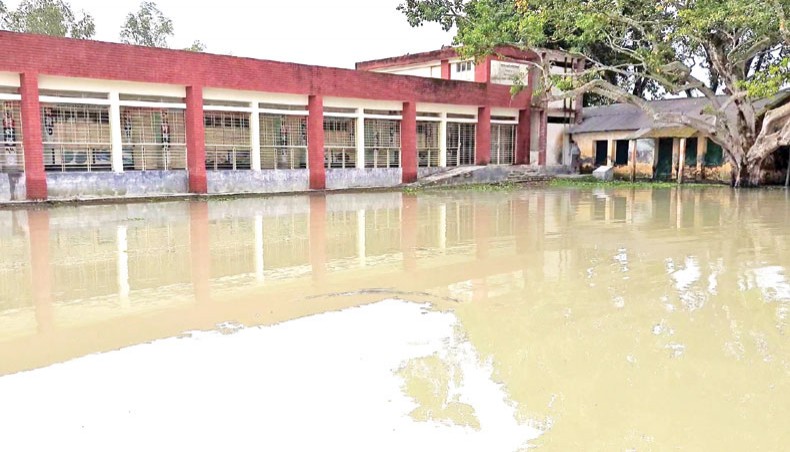
Fresh flood feared in Bangladesh as India opens Gajoldoba again

Floodgates at the Gajoldoba barrage across the border have been opened again on Wednesday noon, sparking fresh flood fears across the northern districts as the River Teesta swelled 35 centimetres in the gap of 24 hours until the opening of the barrage.
This is the sixth time since June that the Gajoldoba barrage floodgates were opened causing inundation in low-lying areas in downstream Bangladesh.
Following the latest opening of the floodgates, the onrush of water from upstream substantially increased, Water Development Board officials said, adding that there is little prospect of floodwaters receding soon.
‘The Teesta is swelling again and flowed five centimetres below the danger level at Dalia point at noon after all the gates at the Gajoldoba barrage have been opened,’ WDB executive engineer Asfauddulla told New Age correspondent in Lalmonirhat on Wednesday.
A total of 32 floodgates at the Teesta Barrage in Bangladesh have been opened after the pressure of the water released from the Gajoldoba barrage in India increased suddenly, he said.
At noon the water flow at the barrage point was measured at 39,600 cusecs, up from 28,000 cusecs measured 24 hours ago, said WDB officials.
It is typical of India to release water through the Gajoldoba barrage frequently during monsoon, often without prior warning, when water pressure on the barrage increased following heavy rains.
Waves of flood washed away fish farms, livestock, houses and other infrastructures in northern districts, though the destruction caused this year by the flood was less compared with the previous year.
WDB’s northern zone chief Jyoti Prasad Ghosh said that over 70,000 people had been stranded in floodwater in the low-lying areas, particularly in the northern region, home to 653 chars.
Over half the flood-affected people in the northern region are from Gaibandha as it emerged as the worst-hit district, followed by Kurigram, Lalmonirhat and Rangpur.
‘We have been in the water for 20 days now,’ said Shefali Bewa, a resident of Char Belka of Gaibandha’s Sundarganj.
The reason Gaibandha and Kurigram districts emerged as the two worst flood-hit districts is that both the Teesta and the Brahmaputra rivers are flowing at full force.
India’s Central Water Commission website showed that the Brahmaputra was flowing above the danger level and close to the danger level in many places in Assam, indicating that water pressure through the river would continue for some time.
The Brahmaputra has fallen below the danger level inside Bangladesh but the areas on its bank still lay inundated.
The Flood Forecasting and Warning Centre in its daily flood bulletin said that the country’s major rivers were falling which may continue over the next 72 hours until 9:00am on Saturday.
Floodwater may recede from Sirajganj, Pabna, Tangail, Manikganj, Rajbari, Faridpur, Munshiganj and Shariatpur districts in 24 hours until 9:00am today, said the FFWC flood bulletin.
Nine rivers of the country, including the Padma, continued to flood their banks at a dozen points, mainly in central and southeastern districts.
Rivers around Dhaka are also full to the brim but did not overflow their banks, according to the FFWC.
‘Dhaka will not see flooding,’ said FFWC executive engineer Arifuzzaman Bhuyan.
India’s CWC flood map however reported continued flooding at many places along the Ganges upstream.
Bangladesh Meteorological Department senior meteorologist Abdul Mannan said that chances of widespread rain inside Bangladesh over the next five days are very slim.
‘Upstream areas in India, Nepal and Bhutan however have seen substantial rainfall in August and all that waters have not been drained yet,’ said Mannan.
The River Muhuri in Feni has fallen below the danger level, however, some of the villages that were inundated following embankment breaches are still under floodwaters, local WDB officials said.
The overall flood situation may end by the second half of the month, said Mannan.
Bangladesh Sangbad Sangstha reported that people displaced by the flood continued returning home in the flood-affected northern districts.
Editor & Publisher: S. M. Mesbah Uddin
Published by the Editor from House-45,
Road-3, Section-12, Pallabi, Mirpur
Dhaka-1216, Bangladesh
Call: +01713180024 & 0167 538 3357
News & Commercial Office :
Phone: 096 9612 7234 & 096 1175 5298
e-mail: financialpostbd@gmail.com
HAC & Marketing (Advertisement)
Call: 01616 521 297
e-mail: tdfpad@gmail.com